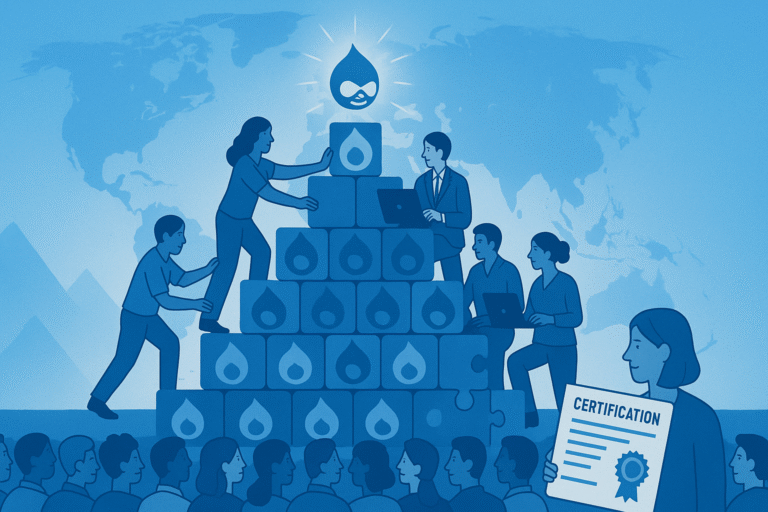Jul 04, 2025
Every modern app deals with data – this could be in the form of user account info and tracked order details, or it could be powering product searches or visitor recommendations. Behind any of these, there’s usually a database making it all work, and one of the most popular of these is PostgreSQL.
In this guide, we’ll have a look at what the PostgreSQL database is, what it offers, and why it’s so popular. By the end, you’ll have a good understanding of this tool and will know if it’s a good fit for your next project.
What is PostgreSQL?
PostgreSQL is an object-relational database management system (ORDBMS) that stores data in columns and rows of a table, which are linked by relationships. You interact with it using SQL (Structured Query Language), just as you would when querying MySQL or SQL Server. It supports:
- Complex queries and modern SQL features like window functions, foreign keys, and common table expressions.
- ACID-compliant transactions, for strong data integrity.
- Concurrent users without slowdowns, thanks to MVCC.
- Flexible data handling, including support for structured, semi-structured, and even geospatial data.
It does not stop there. What truly sets PostgreSQL apart is its extensibility. You can:
- Define custom data types, like coordinates, currencies, or version numbers.
- Use table inheritance, letting one table build on another’s structure – something most relational databases don’t offer.
- Add stored procedures and triggers to handle logic inside the database itself, using SQL statements, PL/pgSQL, Python, or other languages.
It also handles advanced data types, including arrays, JavaScript Object Notation (JSON), Extensible Markup Language (XML), and key-value pairs – all in the same database engine.
The PostgreSQL database is a system built for scale. It’s stable under heavy loads, supporting advanced data integrity features such as write-ahead logging and point-in-time recovery.
Because of this, it’s the database of choice for many, including notable PostgreSQL users such as Reddit, Instagram, TripAdvisor, OpenAI, and even the International Space Station.
Think of PostgreSQL as the Swiss Army Knife of databases. Other databases are better for specific scenarios – for a key-value database, Redis is much more efficient. If you value data flexibility, MongoDB is your best choice. If you want something fast and lightweight, you’d use SQLite. PostgreSQL is not the best at any of these things, but it is good at all of them.
What are the main features of PostgreSQL?
PostgreSQL has several noteworthy features that contribute to its reputation. Here are a few that stand out.
Open-source and community-maintained
PostgreSQL is a free, open-source database project maintained by an active global community and coordinated by the PostgreSQL Global Development Group. However, it may be different from what you’re used to with modern open-source projects, owing to PostgreSQL’s long development legacy.
Object-relational features
In addition to standard data, PostgreSQL supports complex data types, data inheritance between tables, and user-defined types.
Advanced SQL and procedural tools
PostgreSQL includes features such as window functions, common table expressions (CTEs), recursive queries, and effective full-text search. It also allows you to write stored procedures and functions using languages like PL/pgSQL, Python, or SQL.
Performance and query optimization
PostgreSQL efficiently executes complex queries thanks to its query optimizer. Other performance features include diverse indexing methods, index-only scans, and materialized views.
Scalability and concurrency
PostgreSQL manages multiple concurrent database transactions smoothly using Multiversion Concurrency Control (MVCC). It supports table partitioning, asynchronous replication, and database clustering for high-availability and large workload setups.
Data integrity and fault tolerance
PostgreSQL adheres to ACID principles (Atomicity, Consistency, Isolation, Durability), ensuring the integrity of your data. It also uses write-ahead logging (WAL) as an extra level of reliability.
Support for hybrid data models
PostgreSQL supports both structured and semi-structured data. It supports JSON and XML data, key-value pairs, and geographic data through extensions like hstore and PostGIS.
Cross-platform and language-compatible
PostgreSQL runs effectively on major operating systems, including Linux, macOS, and Windows. It works well with nearly every programming language and can be deployed in containerized, virtualized, or physical environments.
What are the everyday use cases for PostgreSQL?
To better understand the benefits of PostgreSQL, let’s examine some real-world use cases:
Web and mobile applications
PostgreSQL high efficiency with write operations makes it a great option to support dynamic websites and mobile applications that have constantly updated data. Think ecommerce websites, where inventory, payments, and customer data is always changing, or mobile games, where player stats, game data, and session information need real-time updates.
PostgreSQL also works with popular frameworks like Django, Laravel, and Node.js, so you don’t need to force PostgreSQL to fit your stack – in most cases, it will integrate naturally.
Financial services
With financial software, four key factors are essential: speed, consistency, accuracy, and stability. Luckily, PostgreSQL ticks all four boxes.
For speed, you get highly efficient indexing, a great query optimizer, and write-heavy workloads like payment information or balance updates work naturally with PostgreSQL.
Custom data types ensure your data remains consistent with your defined rules. Strict ACID compliance and write-ahead logging ensure all your data is accurate and consistent.
Support for high availability, containerization, and MVCC ensures you can run PostgreSQL even at enterprise scales.
Geospatial applications (PostGIS)
By using PostGIS, PostgreSQL goes beyond a standard relational database and can efficiently act as a geospatial data store for location-based services.
Imagine a logistics company that needs to track vehicle locations using PostGIS and correlate them with standard table storage to see active orders and their locations, all in one view.
Or, consider a navigation app that stores location data and uses algorithms to determine the best route, and displays information about those locations in a simple table.
All of this can be achieved with PostgreSQL by combining the geospatial capabilities of PostGIS with simple relational database functionality – all under one engine.
Analytics and data warehousing
For analytics and data warehousing, your database engine must handle both data storage and retrieval quickly. While not as efficient as a dedicated data warehouse and analytics service, PostgreSQL handles these workloads surprisingly well.
With materialized views, common table expressions (CTEs), and indexing strategies, you can crunch large datasets and generate reports efficiently.
If you need a lightweight data warehousing solution and don’t want to commit to a dedicated service, chances are PostgreSQL will be able to meet your basic data analysis needs.
Enterprise systems and complex transactions
Large organizations prioritize three key aspects in a database: scalability, adaptability, and cost. PostgreSQL covers all of these.
It scales extremely well. You can run PostgreSQL as a container in a Kubernetes cluster and orchestrate autoscaling; you can use sharding to split your huge data sets and make them more efficient to query; and, you can lean on multiversion concurrency control to ensure your database won’t screech to a halt when multiple users query your database.
PostgreSQL’s extensibility allows you to tailor your database to your specific needs by defining custom data types, utilizing various forms of data, and writing stored procedures in multiple procedural languages. If you need something specific, you can always take it one step further and add plugins to enhance your database.
Since PostgreSQL is open-source, this means it’s completely free – no costs for users, and no licenses or fees. You only pay for hosting the database itself and the resources it will consume.
Why choose PostgreSQL over other databases?
When researching database systems such as PostgreSQL, you have likely also encountered MySQL, MongoDB, and MariaDB as alternatives. Each of them has its strengths and weaknesses. Here’s a quick comparison.
PostgreSQL vs MySQL
Both PostgreSQL and MySQL are reliable relational database management systems that are similar, but tailored for different scenarios:
- MySQL excels at straightforward database operations. It’s fast, efficient, and outperforms PostgreSQL for read-heavy workloads. However, it lacks many of the advanced features that PostgreSQL offers and tends to struggle with high workloads, especially write operations.
- PostgreSQL, on the other hand, offers more sophisticated features like advanced SQL queries, stronger ACID compliance, richer indexing options, and better support for complex transactions.
There are two main items to evaluate:
- Workload type: If you anticipate a read-heavy workload, MySQL will perform better. If it’s a write-heavy workload, go for PostgreSQL.
- Advanced feature requirements: If you think you will need some of the more sophisticated features that PostgreSQL offers further down the line, it may be worthwhile to start with it – migrating to another database engine isn’t an easy task. But if you just need a simple database, MySQL is a perfectly valid option.
PostgreSQL vs MongoDB
MongoDB is a NoSQL database system for flexible, document-based storage, so comparing PostgreSQL and MongoDB is not as straightforward.
- MongoDB stores data using JSON-like documents and is highly efficient in this particular use case. However, because of that, it lacks the structure that a relational database system offers. It’s a very specific database for solving a very specific problem.
- PostgreSQL, meanwhile, offers robust structured data handling combined with JSONB capabilities, allowing it to store and query semi-structured data effectively. However, it does not match MongoDB in efficiency for this type of data.
In essence, if you’re only working with documents and unstructured data, you may not need a relational database, making MongoDB your best bet. But if you see a need for data types beyond MongoDB’s documents in the future or require a hybrid approach, PostgreSQL offers most of what you will realistically need.
PostgreSQL vs MariaDB
MariaDB is essentially an enhanced MySQL version, well-suited for applications that benefit from MySQL’s simplicity but require additional performance optimizations and easier database management.
This comparison will often come to mind when you’re already using MySQL and are considering a migration. In this case, the real question to ask is: Why is MySQL not enough?
- If MySQL was the best fit for you, but you needed better database performance, or database management was becoming too complex, migrating to MariaDB is the next logical step.
- If MySQL was not a good fit because the general feature set was insufficient, or your workload shifted to a heavier write load, it’s worth considering PostgreSQL.
In all the above cases, PostgreSQL can be outperformed in some scenarios by its counterparts. However, one key thing that sets it apart is that of all these database frameworks, it’s the only one that can cover the use cases from the other three.
If using MongoDB, you would not even consider MySQL or MariaDB or vice versa, while PostgreSQL can replace them both.
This makes PostgreSQL a safe bet. If you’re not sure what database you need, chances are that PostgreSQL will work for you. It may not be the best in your use case, but it will get the job done.
How to get started with PostgreSQL?
To start with PostgreSQL, all you really need is somewhere to run it. You can install and run the PostgreSQL database server locally and run it as a service, host it on a virtual private server (VPS), or run it inside Docker containers. You can host it on a bare-metal machine or in a cloud environment.
PostgreSQL runs on all major operating systems, including Linux, macOS, and Windows, and has relatively modest system requirements. A small PostgreSQL server needs just 1 GB of memory and a few hundred megabytes of disk space to get started.
If you think PostgreSQL is the right database for you, follow our PostgreSQL installation guide to get it up and running on your VPS quickly.

Conclusion
PostgreSQL stands out because it effectively combines flexibility, consistency, and advanced features, making it suitable for a wide range of projects, from small personal apps to complex enterprise systems.
While it isn’t the best choice in every scenario, its real advantage lies in its versatility. PostgreSQL comfortably handles structured and semi-structured data, complex queries, and ensures data integrity without licensing costs or vendor lock-in. This flexibility is what makes it the primary database for many.
If you need a database that’s flexible enough to adapt as your projects grow or your requirements change, PostgreSQL is a practical and reliable choice.
What is PostgreSQL? FAQ
What is PostgreSQL used for?
PostgreSQL is used to manage data for websites, mobile apps, financial systems, geographic information systems (GIS), analytics platforms, and more.
Its support for multiple data types, reliable transactions, and strong data integrity make it a solid choice for everything from small tools to complex enterprise software.
Is PostgreSQL free to use?
PostgreSQL is a fully open-source relational database management system distributed under the PostgreSQL license. You can use, modify, and distribute the software and source code without paying any licensing fees.
That said, while the software itself is free, hosting costs still apply if you plan to run it on a server.
Can PostgreSQL handle non-relational data?
It can. While PostgreSQL is a relational database at its core, it also supports non-relational formats, such as JSON, XML, arrays, and key-value pairs (via the hstore extension).
Additionally, PostgreSQL supports geographic objects through the PostGIS extension. This flexibility makes it great for hybrid applications that combine structured and semi-structured data.
All of the tutorial content on this website is subject to
Hostinger’s rigorous editorial standards and values.







